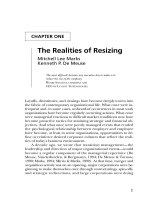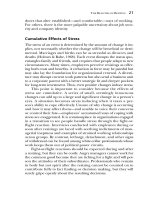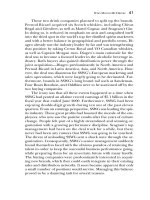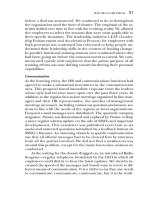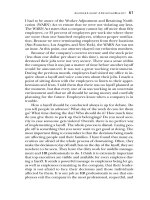Resizing The Organization 5 ppt
Bạn đang xem bản rút gọn của tài liệu. Xem và tải ngay bản đầy đủ của tài liệu tại đây (92.45 KB, 10 trang )
dures that alter established—and comfortable—ways of working.
For others, there is the more palpable uncertainty about job secu-
rity and company identity.
Cumulative Effects of Stress
The stress of an event is determined by the amount of change it im-
plies, not necessarily whether the change will be beneficial or detri-
mental. Marriages and births can be as stressful as divorces and
deaths (Holmes & Rahe, 1968). Each event disrupts the status quo,
entangles family and friends, and requires that people adapt to new
circumstances. Many times, employees perceive resizings as offer-
ing both costs and benefits. A reduction in force may be painful but
may also lay the foundation for organizational renewal. A divesti-
ture may disrupt current work patterns but also send a business unit
to a corporate parent with a better strategic fit and deeper pockets
for long-term investment. Thus, even positive changes induce stress.
This point is important to consider because the effects of
stress are cumulative. A series of small, seemingly innocuous
changes can add up to a large and significant change in a person’s
eyes. A situation becomes stress inducing when it taxes a per-
son’s ability to cope effectively. Unsure of why change is occurring
and how it may affect them—and unable to voice their concerns
or control their fate—employees’ accustomed ways of coping with
stress are exaggerated. It is commonplace in organizations engaged
in a transition to see people handle stress through the fight-or-
flight reaction. Interviews conducted with employees during or
soon after resizings are laced with seething indictments of man-
agerial ineptness and examples of strained working relationships
across groups. By contrast, lethargy, detachment, and other signs
of withdrawal can be found among white-collar professionals whose
work keeps them out of political power circuits.
Fight-or-flight reactions should be expected during and after
a resizing, but they can be costly. Angry managers cannot work for
the common good because they are itching for a fight and will poi-
son the attitudes of their subordinates. Professionals who remain
in body but not spirit after the resizing cannot be counted on to
contribute fully to fact finding or decision making, but they will
surely gripe openly about the resulting decisions.
THE REALITIES OF RESIZING 21
TEAMFLY
Team-Fly
®
22 RESIZING THE ORGANIZATION
Stress also takes a toll on well-being. Increased drug and alco-
hol abuse is common among workers surviving a transition. In one
company we were consulting for during a resizing, Valium was the
number one prescription drug purchased by employees each of
the six months following initial layoffs. Frequently, calls to em-
ployee assistance programs skyrocket, and it is common to hear re-
ports of a variety of psychosomatic reactions to stress (for example,
trouble falling asleep at night, headaches and back pain, smoking
again after having kicked the habit, and increased tension and con-
flict at home and on the job).
Rates of illness and absenteeism swell at workplaces in transi-
tion, and there are plenty of numbers to document the human and
financial cost of resizing. At a Fortune 500 firm we studied, inci-
dents of high blood pressure among employees rose from 11 per-
cent in the year preceding a resizing to 22 percent in the year
following its announcement. In a study conducted by Northwest-
ern National Life Insurance, 65 percent of employees surveyed re-
ported that they suffered from exhaustion, insomnia, or other
stress-related problems; one-third revealed they were close to
burnout. Stress saps between $100 and $300 billion annually from
the U.S. economy in the form of lost workdays and health care
costs related to illnesses like exhaustion, depression, and heart at-
tacks (“Economy Creates More Stress,” 1992).
The Saturation Effect
Organizations may operate within a context of ongoing change,
continuous improvement, and radical transformation, but people
can handle only so much disruption to their accustomed norms
(De Meuse & McDaris, 1994). We may be in the Internet age with
tremendous technological advances, but the human machine has
a breaking point. Over time, people’s threshold for dealing with
stress, uncertainty, and disorientation is met. Their ability to cope
with ongoing change is impaired, resulting in detrimental atti-
tudes, maladaptive behaviors, disappointing performances, and
the many other unintended consequences of resizing (Pfeffer,
1998).
A resizing rarely occurs in isolation. Rather, it is part of an on-
going series of real and perceived events that contribute to the cu-
mulative stress experience. Consider a Silicon Valley high-tech
firm’s history over a two-year period. After rumors of impending
change and watching events occurring at other companies in their
industry, the firm attempted minor belt-tightening measures to
deal with the softening economy and poor financial results. Then
the company made a more radical move with a major restructur-
ing of operating units and, for the first time in its history, offered
employees a voluntary early retirement program. These activities
were followed by the divestiture of a business unit and the consol-
idation of manufacturing operations, forcing the closing of a plant.
With financial results still slumping, the company resorted to an
involuntary reduction in force.
As characterized in Figure 1.1, each of these events resulted in
the experience of cumulative stress. By the time the involuntary re-
duction in force was announced, many employees had become
numbed by the dizzying course of events. The workforce suffered
an intellectual and emotional paralysis brought on by their satu-
rated coping capacity. They were psychologically worn out, unable
to take on the responsibilities involved in meeting new challenges,
and unwilling to give a good fight.
Shortly after the involuntary reduction in force, the company’s
leadership team saw a genuine potential for financial growth, or-
ganizational success, and individual reward. These executives an-
ticipated that after a long and difficult struggle, victory in an
important battle was awaiting at the top of the next hill. They saw
THE REALITIES OF RESIZING 23
Source: Adapted from Marks (1994, p. 77).
Figure 1.1. The Saturation Effect.
Stress
Rumors
and
Vicarious
Events
Poor
Economic
Results
Restructuring Voluntary
Reduction
in Force
Divestiture
of
Business
Unit
Plant
Closing
Involuntary
Reduction
in Force
Time
Coping Threshold
24 RESIZING THE ORGANIZATION
the goal and confidently rallied their troops on the mission at hand.
The cry came to charge up the hill and take the prize. However, the
troops were neither ready nor willing to charge up the hill. Rather
than focus on the opportunity ahead of them, the employees were
unable to let go of the pain behind them. Their vision of the target
was obscured by the emotional residue of anger, distrust, and de-
pression built up over years of false promises and unmet expecta-
tions. Their self-esteem battered and their faith in the organization
broken, the troops lacked confidence that they could take the hill.
Most significant, they did not see how any personal gain would re-
sult from taking the hill. Instead, they fixated on memories of their
fallen comrades—the casualties of layoffs and closings and the
“walking wounded” whose careers were sidetracked.
Adaptation and Organizational Resizing
To understand why living through a reduction in force, closing, or
divestiture—as either a victim or a survivor—can be so debilitating
to everyone, it is important to consider the process of psychologi-
cal adaptation to change and transition. A change can be of two
types: continuous change and transformational change. The dis-
tinction is based on the extent to which the change requires psy-
chological adaptation.
Two Levels of Change
Continuous change is a path to a known state, with orderly, incre-
mental, and continuous steps. Moving a meeting from a 10:30
A.M.
to a 10:00
A.M. starting time is an example of a continuous change.
It may cause some disruption and require some adaptation; atten-
dees may have to leave other meetings earlier or reschedule con-
ference calls. Nevertheless, the discrete nature of continuous
change lets people know exactly what to expect and allows them
to get on with their lives.
A transformational change, by comparison, is a path to an un-
known state—something that involves many simultaneous and in-
teractive changes. Adopting new ways of thinking, organizing, or
conducting activities are examples of this type of deeper, more
meaningful, and lasting change. Transformational change poses a
break from the past. It involves death and rebirth; existing prac-
tices and routines must be abandoned and new ones discovered
and developed. A corporate cultural change—perhaps getting peo-
ple to stop avoiding risk and start embracing the idea of learning
from mistakes—is an example of a transformational change. A re-
sizing that prompts a reassessment of deep-seeded perceptions and
expectations (for example, “My employer respects and fairly treats
all people” or “Hard work is rewarded here with job security”) also
is a transformational change.
Letting Go of the Old and Accepting the New
For transformational change to occur, a person literally has to let
go of the old before accepting the new. People have to abandon
old attitudes or behaviors before adopting new ones (Bridges,
1980; Lewin, 1947). This helps explain why transformational
change is a much more difficult psychological process than is con-
tinuous change. Perhaps the classic example of a transformational
change is adapting to the death of a loved one. People who expe-
rience the loss of a family member, dear friend, or important col-
league do not wake up the next day and get on with their lives.
They grieve the loss of their loved one and struggle with accepting
new realities. Some people take weeks to go through this natural
and normal process, others take months, and still others take years.
Some individuals never reach the stage of acceptance. Unlike a
continuous change, in which they know exactly what to expect,
mourners encounter tremendous uncertainty and insecurity re-
garding their future. How will they go on living without their loved
one? Who will they turn to for support? What will they do when
they need assistance normally provided by the deceased? All of this
is much more trying on a person’s well-being than simply getting
to a meeting half an hour earlier.
Ironically, CEOs who resize their companies have had time to
let go of the old before accepting the new. Consider the case of the
divestiture of a business unit; it takes months to plan a deal, search
and select a buyer, and gain government approval for the sale. Dur-
ing this time, executives can come to terms with the fact that the
old is being abandoned (“I will no longer be running the largest
company in our industry” or “The company I founded in my
THE REALITIES OF RESIZING 25
26 RESIZING THE ORGANIZATION
garage will never abandon its good performers”) and contend with
new realities (“I am on the path to getting our firm back on sound
financial footing” or “Our employees will no longer be weighed
down by a money-losing division”).
Most individuals, business executives among them, ignore or
deny the discontinuous nature of transformational change. That
is, they ignore or deny the need to let go of the old before accept-
ing the new. As organizational consultant William Bridges puts it,
beginnings start with endings. You do not start the new until you
end the old. This takes time, effort, and patience. Bridges (1980)
highlights three distinct stages of this transformational process: (1)
letting go of the old, (2) dealing with the neutral zone, and (3) ac-
cepting the new.
During the first stage, letting go, the individual comes to see that
the status quo no longer is appropriate for achieving what he or
she desires. For example, a person in the midst of an involuntary
reduction in force would have to abandon attitudes such as “this
is a secure place to work.” The second stage, the neutral zone, is an
ambiguous place in which the old is over but the new has yet to be
achieved. That is, you are no longer what you were but not yet what
you want to become. The employee will have to take some time to
learn by trial and error what behaviors get rewarded in the chang-
ing organization. It is truly a difficult period. Many of our clients
dub this the “twilight zone”: it is dark, scary, and unclear as to what
lies ahead. Finally, a new status quo emerges during the third stage
of accepting the new. People who make it to this stage realize deep,
meaningful, and lasting change. The employee not only accepts
new attitudes about how tenable job security is in today’s work en-
vironment, but also adopts behavioral changes such as networking
with recruiters from other firms on a regular basis. Employees grow
more comfortable with the new reality; externally they are more at
ease, and internally they modify their self-image and develop a new
sense of self-worth.
Once employees figure out and accept new realities, they make
sense out of their new world and grow more comfortable with it.
Obviously, adapting to transformational change is much more psy-
chologically taxing and is a much longer process than is adapting
to continuous change. Even when change is for the better, people
have to cope with uncertainty and the loss of familiar methods and
routines. Transformational change implies the loss of the status
quo, and that loss must be dealt with before people can fully move
on in their work lives.
Unintended Business Consequences of Resizing
The costs of layoffs, closings, and divestitures have been measured
in financial as well as human terms. The Laborforce 2000 study of
downsizing and restructuring found that most companies surveyed
experienced undesirable business consequences. Many companies
were not prepared to handle the work that remained after a re-
duction in force and underestimated the costs required to cover
tasks that had been performed by former employees. Some 41 per-
cent of the companies that resized reported a greater need to re-
train remaining workers. This finding implies that costs were
experienced as a result of taking people off their regular jobs and
training them to do additional jobs. One-third of the companies
increased the use of temporary workers and consultants, often at
a cost higher than the expense of previous employees; a similar
number increased the use of overtime. One in every four firms
contracted out an entire function (Marks, 1993).
In addition, health care costs incurred by organizations rise for
both victims and survivors of resizings. It is easy to see how health
care costs can increase for transition casualties. The psychological
trauma of losing one’s position triggers psychosomatic ailments.
Moreover, early retirees have more time on their hands and, as a re-
sult, more time to visit a health care provider and ring up expenses.
Not so obvious—but equally costly—are increased health care costs
for the survivors, who also are subjected to the psychosomatic ef-
fects of intense stress on the job. A study of Boeing employees
found that individuals who experienced a high degree of emotional
stress on the job were more than twice as likely to file back injury
claims than other employees (Gaines, 1993). Working harder to
cover the tasks of others also results in a higher accident rate. One
study of 177 companies found that although the average workforce
was cut by only 13 percent over a fifteen-month period, fully one-
third of the firms reported an increase in workers’ compensation
claims. One in five companies said their workers’ compensation costs
increased between 50 and 100 percent (“A Study of Worker,” 1992).
THE REALITIES OF RESIZING 27
28 RESIZING THE ORGANIZATION
In yet another study, a team of English researchers investigated the
physical and emotional health of 764 employees whose organiza-
tions were downsizing. They found that employees in work groups
experiencing job cuts were more than twice as likely to take sick
leave as employees in a cohort work group (Kivimaki, Vahtera,
Pentti, & Ferrie, 2000). If survivors perceive there may be another
wave of layoffs, they likely will get the annual physical or dental
work they have been putting off for the past several years.
As for the impact of resizing on productivity, an American Man-
agement Association study found that companies that had resized
were as likely to report a decline in productivity as an increase.
Fewer than half of the resized firms increased profits after the cuts
were made, and one-quarter of them reported a decline in oper-
ating profits. In testimony before the Joint Economic Committee
of Congress, the study’s director concluded, “The after-effects of
downsizing are problematic at best and raise the question as to
whether the cure is worse than the disease” (Lesly & Light, 1992).
There is a more subtle unintended business consequence of
resizing. Recent authors contend that such activities disrupt or
damage an organization’s ability to learn and adapt to the chang-
ing environment because the informal communication networks
are adversely affected (Fisher & White, 2000; Lei & Hitt, 1995). Ob-
viously, there is a loss of corporate memory and organizational her-
itage as long-term employees are terminated. Unless they are
carefully managed, many of the more skilled and valuable em-
ployees will choose to leave. Consequently, the overall knowledge
base in an organization unwittingly can be lowered.
No matter what the economic justification, an organization
that chooses to resize as opposed to taking other steps (such as
shorter workweeks, forced use of vacation times, or reductions in
executive compensation) suffers the stigma of being perceived as
a firm that is willing to cast its people aside in the search for prof-
its. There is no doubt that prospective future employees regard a
firm like Hewlett-Packard, which historically has been regarded as
one of the best places to work in the high-technology industry, less
favorably after it engages in involuntary reductions in force than
before ever considering such an action. Moreover, there is no
doubt that surviving employees at other plants and offices shud-
der, feeling less secure and less satisfied with their employers when
General Motors announces plant closings. And there is no doubt
that future employees who will be acquired by Vivendi as the dy-
namic firm continues to grow will recall how the French company
divested thousands of employees as it picked through acquired Sea-
grams, retaining the entertainment holdings while casting aside
the core spirits and wine business. Ironically, it was the Spirits and
Wine Division that generated profits enabling Seagrams to acquire
its entertainment units.
The unintended impact of resizing spreads beyond employee
ranks and into the perceptions and behaviors of customers as well
(Bastien et al., 1996). Customers fret when they hear that a com-
pany with which they are doing business is about to lay off employ-
ees, close an operation, or sell a unit. They know that employees
will be distracted from work, productivity will plummet, and qual-
ity will suffer. In fact, many manufacturing firms have gotten to the
point where they automatically line up secondary sources when they
learn a supplier is anticipating or engaging in a resizing. And when
customers have had prior experiences with resizing firms—whether
they are large industrial firms receiving raw materials of poor qual-
ity or individual consumers fed up with waiting in long lines at a fi-
nancial institution—they will take their business elsewhere.
Resizing often is a sound and sensible strategy. We are not de-
bating or questioning that point. Rather, our intent is to examine
the various ways in which resizing has a direct and indirect impact
on organizations and their stakeholders. Our goal is to identify the
methods that can be used to minimize the unintended conse-
quences while maximizing the opportunities to use resizing as a
stimulus to build a new and better organization for the long haul.
The Healthy Side of Organizational Resizing
Certainly, organizations need to right-size by eliminating unnec-
essary work, shedding underperforming or nonessential units, and
responding to economic, legal, technological, regulatory, and con-
sumer changes. If organizations did not change, they would not re-
main competitive. Organizational leaders, however, must come to
terms with the fact that the way in which they resize their opera-
tions affects employee motivation, team performance, and orga-
nizational effectiveness.
THE REALITIES OF RESIZING 29
30 RESIZING THE ORGANIZATION
Resizing does not imply that organizations are malevolent in
their actions. In many cases, layoffs, closings, and divestitures are
prudent business moves that enhance competitiveness and surviv-
ability in the constantly changing business environment. The elim-
ination of jobs at CNN following the AOL Time Warner merger,
United Airlines’ closing of money-losing stations as firms slashed
travel budgets in 2001, and Vivendi’s divestiture of a liquor busi-
ness that was outside its managerial expertise are the kinds of steps
that have to be taken to increase the likelihood that the firms, and
their many remaining employees, will endure and prosper over the
long term.
Resizing can be beneficial for organizations and their people.
Companies wallowing in red ink are wise to eliminate a portion—
be it 5, 10, or even 20 percent—of the workforce to strengthen the
survivability of the vast majority of employees. A serious assessment
of workforce apportionment and strategic business mix is an inte-
gral component of the organizational introspection needed to re-
balance and reposition a firm and its resources to take better
advantage of emerging market trends and technological changes.
Transitions also can spark organizational regeneration. A CEO
or business unit leader with the right mix of visionary and charis-
matic leadership skills can rally employees around the notion that
the transition is not only a necessary response to business realities,
but an opportunity to improve how work is approached and con-
ducted in the organization. Resizing holds the potential to un-
freeze the organization and its people, providing a rare chance to
change corporate culture dramatically and reinforce a new way of
doing things. A middle manager or supervisor can use the un-
frozen state as an opportunity to strengthen teamwork, increase ef-
fectiveness, and identify and correct impediments to productivity
in his or her work group.
Individuals can experience a personal form of renewal as a re-
sult of company resizing. Although many employees remain mired
in maladaptive responses to the stress and uncertainty of a down-
sizing or divestiture, others come to recognize that in crisis there
is opportunity (Bardwick, 1995). One senior executive who had
lost his job in a major organizational restructuring revealed, “When
shrubs are transplanted, there is new growth and new life. I know,
because it happened to me.” Searching out ways to gain from the




